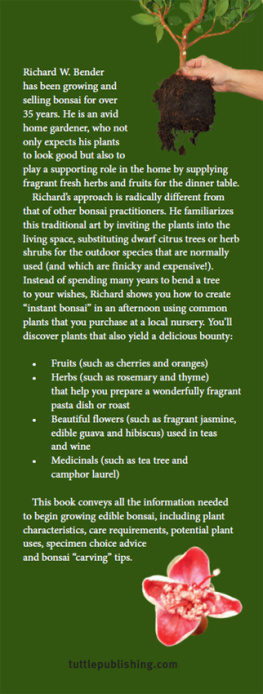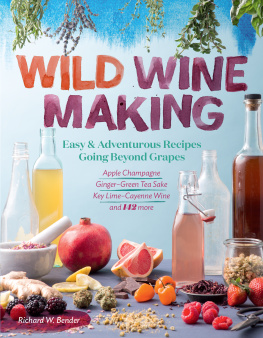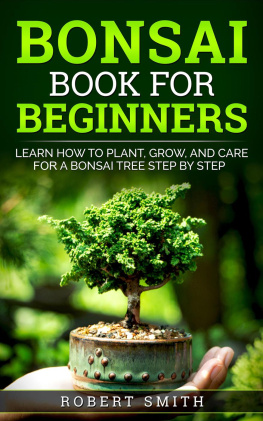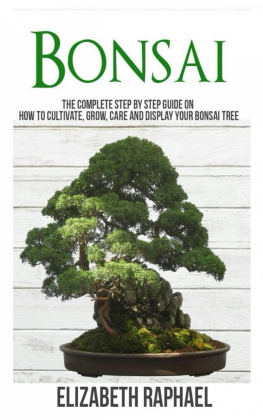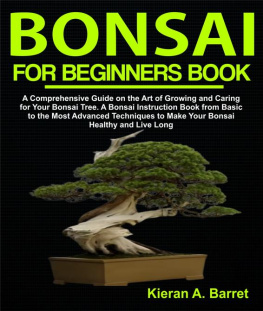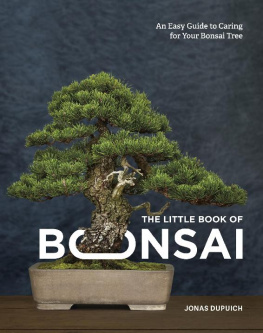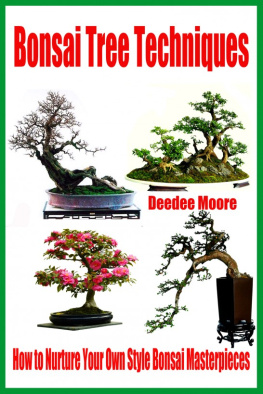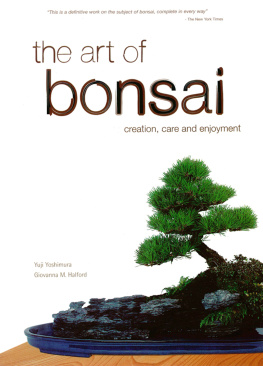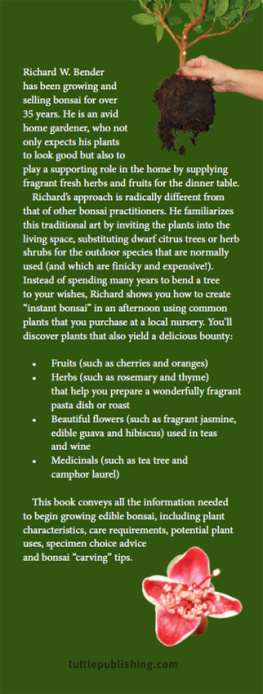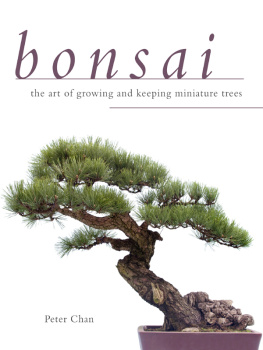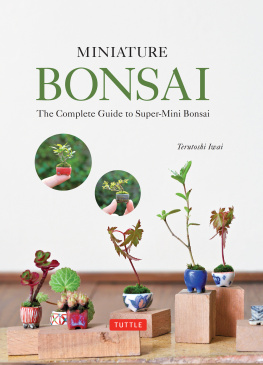
CHAPTER 1
Bonsai: An
Overview
W hile the history of bonsai goes back several hundred years in its modern form as developed by the Japanese, there is no doubt that mankind has shaped plants for as long as humans have grown and tended them. The first plants grown in containers were most likely valuable herbs or food plants that the growers wanted to transport or protect from harm. The oldest images of potted plants come from Egyptian paintings; Hindu doctors were known to keep medicinal plants in pots for easy cultivation and transportation around 1000 BCE.
Bonsai became a well-developed art in China during the first millennium CE, as evidenced by the first writings and paintings about bonsai as an art form. By the time of the Sung dynasty, around 1000 CE, bonsai as an art form was spreading throughout Chinese culture with paintings, poetry, and technical instructions in the literature of the time. It was probably around this time that bonsai was introduced into Japan, most likely by Buddhist monks; the first written records of bonsai appeared there around 1300 CE.
Bonsai developed into its modern form in Japan with very strict styles and conventions that mirrored the structured society in which it developed. Specimens were mostly grown outdoors, and were often tended for generations, passing from father to son, using native plant varieties that were suited to the local climatic conditions. Western society was exposed to the art of bonsai during the twentieth century, particularly during the aftermath of World War II. Many American GIs who spent time in Japan after the war became fascinated by aspects of Japanese culture, and bonsai was an interest that some of them brought home. The Karate Kid movies, the first of which came out in 1984, introduced bonsai to a new generation of children in the US. In fact, 1989s Karate Kid, Part III opened with the karate master Mr. Miyagi fulfilling his lifelong dream of opening a bonsai shop. A bonsai theme was prominent in that movie, including recapturing a repatriated bonsai tree that Mr. Miyagi had planted back in the wild after bringing it to America from Okinawa. Throughout the 1980s, as a bonsai artist managing several garden centers I witnessed an amazing number of children, primarily boys, who were looking for bonsai like Mr. Miyagis trees. Millions of children were exposed to and fascinated by bonsai as a result of this type of mass-media attention. Traditional Japanese bonsai had captured the imagination of the West.
Unfortunately, many of the resulting attempts at cultivation were unsuccessful. Millions of juniper bonsai died in peoples homes as buyers reached out to embrace a fad without understanding the conditions required to keep these trees alive. Traditional Japanese-style bonsai primarily uses outdoor trees that require a cold dormant period to thrivejunipers, pines, and maples. These outdoor varieties are not suitable for use as houseplants, and seldom last long indoors. As the art of bonsai gained a foothold in the West, however, more indoor varieties were used, because people wanted bonsai that could be put in the house and treated like houseplants.
The art of bonsai has developed with several different philosophies or schools of thought beyond the traditional Japanese style. The use of strictly indoor varieties has become most prominent of these, embracing many new varieties beyond the usual ficus and serissa that were among the few tropical varieties used by traditional Chinese and Japanese bonsai artists. A sideline to this is the specialization in flowering varieties. Another philosophy, similar to traditional Japanese-style bonsai, strives to use only local varieties native to the region and grow them outdoors.
An older style that seems to be losing favor is the collection of wild, natural bonsai. This is understandable, as the field trips to wild areas to collect natural bonsai that this tradition involved resulted in the defacement of natural areas and losses from digging up trees in the wild. Modern environmental ethics preclude digging wild bonsai from our dwindling natural areas.
There is still a place, however, for collecting wild natural bonsai when cleaning brush from cultivated fields, lawns, or vacant lots. Some amazing bonsai can be collected when cleaning out old yards and fields, without damaging our natural areas. A friend clearing brush from a lot collected one of the most unique bonsai Ive ever seen, a wild elm with a two-inch diameter trunk that was cut off twelve inches above the ground and potted into a six-inch plastic pot. A year later, this stump had developed a fine, strong set of roots and a fringe of branches growing around the rim of the stump. My friend had always wanted a hollow-trunked bonsai, so as a demonstration at a bonsai show, he used a one-inch bit and a hand drill to hollow the trunk straight down from the top to an inch above the ground and in from the side to meet the bottom of that hole. He then took a two-handed electric router and carved a jagged lightning strike down several inches from one side of the top and shaped the hole from the side. As wood chips were hitting the roof of the greenhouse, the traditional bonsai artists in attendance gaped in amazement at the scene unfolding in front of them. I saw that tree again a year later, and it had survived the harsh treatment.
Using herbs as subjects for bonsai was only mentioned a handful of times in the previous history of bonsai writing before the publication of my article Herbs as Bonsai in the November 1987 edition of Horticulture magazine, which was followed by my book Herbal Bonsai in 1996. Herbal bonsai changes the whole timescale of bonsai development because of its comparatively fast growth. Impressive specimens can be created in as little as one growing season with a plant such as rosemary, yet these plants can be kept alive in pots for fifty years or more. A moderately large herbal bonsai can provide homegrown fresh herbs in sufficient quantity to supply a household. Growing herbs indoors can be a little trickier than cultivating tropical plant varieties, but the idea of consuming your bonsai trimmings leads naturally to considering a fruiting bonsai that provides a usable harvest.
It seems a little incongruous to think of a bonsai tree providing enough harvest to amount to much, but bonsai dont have to be miniature. Even traditional Japanese classifications include bonsai up to six feet tall. An edible fig or a citrus tree of that size can provide an amazing amount of fruit. I have harvested enough of these fruits to make jam and to ferment into wine (although I will admit to freezing an entire crop and using a couple of crops to make two cases of wine). A friend asked whether I pour tiny glasses of bonsai wine. I replied, Of course, we use sake cups to help provide the proper ceremonial courtesy when sharing such a rare vintage.

Limequat Mariachi wine.
Citrus trees have an added advantage in that most citrus fruits can sit on a tree for several months after becoming ripe without going bad, and can be picked fresh when ready to use. With a small collection of several varieties of citrus, it is possible to have fresh citrus to pick nearly 365 days a year, even in places like my home in the Colorado mountains. You may not be able to pick one every single day of the year, but it is quite reasonable to expect to pick a couple of fruits a week for cooking purposes. Varieties with smaller fruits have more appeal strictly as bonsai specimens, and also provide a bigger crop than large-fruited varieties. These small varieties include calamondin orange, kumquat, Key lime, and the harder-to-find limequat (a lime-kumquat cross). The limequat is the heaviest bearer of fruit in my experience, and my calamondins here in Colorado usually produce two crops a year.

